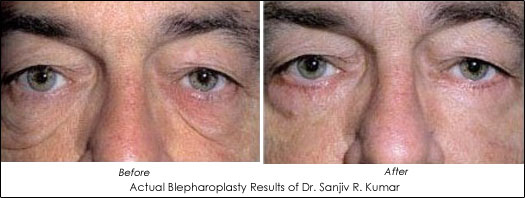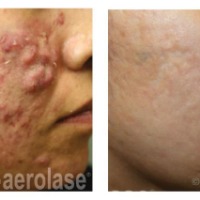The eyes are the focal point during human communication. We pay so much attention to the eyelid skin surrounding a person's eyes during conversation and eye contact. Because of this, it is not surprising that every year one hundred thousand men and women choose blepharoplasty to improve their appearance. Aging changes of the eyelid can convey an inappropriate message of tiredness or sadness. In some cases, the eyelid drooping can be significant enough to block vision. Blepharoplasty corrects these problems and can remove puffiness and bags under the eyes.
What causes bags under the eyes? Sun damage is one pathologic process that contributes to this problem. Genetic factors may also contribute. The orbital septum and eyelid muscles are normally responsible for holding back the orbital fat. As they become weak, the orbital fat protrudes due to the action of gravity. Blepharoplasty is defined as excision of excessive eyelid skin, with or without orbital fat. The surgery has the effect of tightening the periorbital structures to give a more youthful appearance. The procedure is performed under local anesthetic as an outpatient or office procedure. In the past, surgical steel instruments were used but most offices now utilize modern radiosurgery or laser techniques.
How is blepharoplasty performed? For the upper lids, the surgeon first marks the individual lines and creases of the lids in order to keep the scars as invisible as possible along the natural folds. The incision is made and excess fat, muscle, and loose skin are removed. Fine sutures are then used to close the incisions and hide any scar within the upper eyelid crease. For the lower lids, the surgeon makes the incision along the lashline or can hide it completely by a transconjunctival approach. In either case, excess fatty material is removed. Under normal conditions, blepharoplasty can take one to two hours.
Eyelid surgery is the most common invasive cosmetic surgical procedure of the face. This is why there are such a variety of specialists who perform this including ophthalmologists, plastic surgeons, dermatologists, general surgeons, and basically any physician with a medical spa. Ophthalmologists are the best-trained group to perform cosmetic eyelid surgery. After a patient has had cosmetic surgery to look better, they want to have eyelids that work well and allow them to have normal vision. Most ophthalmologists will relay that cosmetic surgery of the eyelids is very different than plastic surgery on the rest of the body. There is a greater requirement for attention to fine detail and microsurgery. Patients need a good functional outcome for the long-term health of their eyes.









